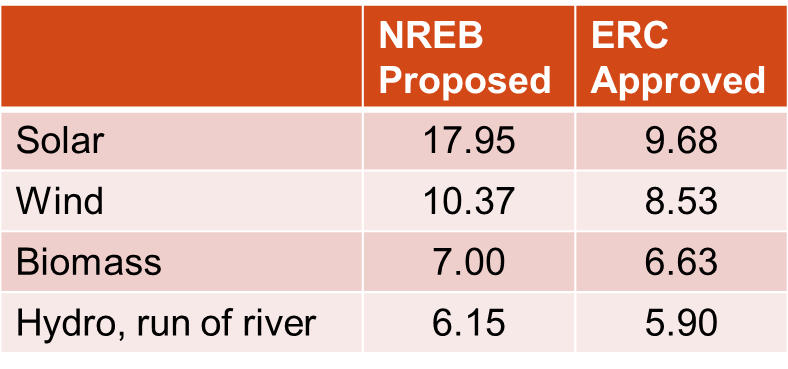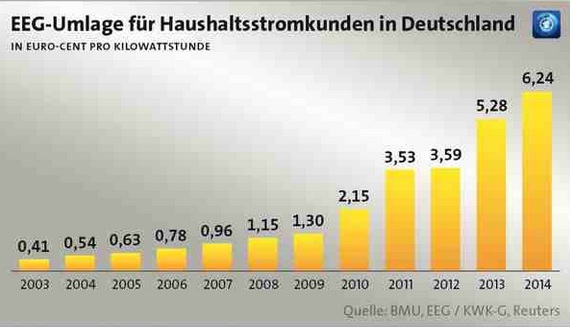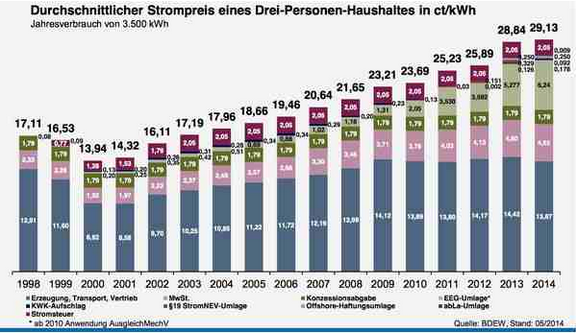 By Nonoy Oplas
By Nonoy Oplas
The Philippines enacted the Renewable Energy (RE) Act of 2008 (Republic Act 9513), which contains various subsidies for renewable energies such feed-in-tariffs (FIT).
Photo: Nonoy Oplas
While it was signed into law in December 2008, FIT was not implemented until July 2012 because many sectors including manufacturing opposed higher price on already expensive Philippine electricity rates. But the World Wildlife Fund (WWF), Greenpeace and other environmental groups in the country lobbied hard to implement the FIT and the Energy Regulatory Commission (ERC) was pressured to give in to their lobbying, but at a lower rate as requested by the National Renewable Energy Board (NREB).
Figure 1. Proposed vs approved FIT in the Philippines, pesos per kWh. (Rates approved in mid-July 2012).
Prior to July 2012, there were not many renewable plants that were put up because of the uncertainty when the FIT would be granted and implemented. After July 2012, there was certainty and more renewables were put up.
The ERC started public hearings regarding how much would be added to the monthly bill of electricity consumers in the Philippines when FIT is reflected. In August 2014, the National Transmission Corporation (Transco), the FIT administrator according to the law, said that the forecast annual payout for renewable energy companies based on the FIT petition would be P8.5 billion ($192.3 million) for 2015 and P10.25 billion ($231.9 million) for 2016. Wow! (Source: Philippine Star).
Last February, Manila Electric Cooperative (Meralco) and all other electric cooperatives and distribution utilities in the Philippines started collecting the introductory FIT of PHP 0.04 per kWh. If this rate is retained throughout the year, the projected collection by Transco to be distributed to the renewable firms will be PHP2.7 billion. If the 12 percent VAT is included, this will be a P3.02 billion (US$ 68.3 million, at prevailing P44.2/$ exchange rate) siphoning from the pockets of electricity consumers nationwide.
FIT rate will be adjusted and rising through time as more renewables are added to the country’s power generation mix.
Rising FIT has happened and continues to happen in Germany, which probably has one of the world’s most elaborate renewables subsidy schemes. The FIT keeps rising as more renewables, wind and solar especially, are added yearly to the energy mix and electricity distributors are forced to buy them even when cheaper electricity from coal, natural gas, nuclear and hydro are available.
Figure 2. FIT paid by consumers in Germany, in Euro cents per kWh. Source: BMU: Germany’s Electricity Price More Than Doubles…Electrocuting Consumers And Markets, 7 December 2014.
So electricity prices in Germany keep rising. This will happen to the Philippines too, no thanks to RA 9513 the renewables cronyism law.
Figure 3. Cost paid by households in Germany, Euro cents per kWh. Source: BDEW: Germany’s Electricity Price More Than Doubles…Electrocuting Consumers And Markets, 7 December 2014
What makes FIT a formula for ever-rising price of electricity? As contained in Section 7 of RA 9513, the FIT forces the following:
(a) Priority connections to the grid for electricity generated from emerging renewables such as wind, solar, ocean, run-of-river hydropower and biomass power plants,
(b) Priority purchase and transmission of, and payment for, such electricity by the grid system operators;
(c) Fixed tariff to be paid to renewables producers for 20 years; and
(d) Compliance with the renewable portfolio standard (RPS).
The RPS as contained in Section 6 of the law, is the minimum percentage of generation from eligible renewable energy resources to be set by the NREB.
So combining FIT and RPS, this means that even if cheaper power from say Quezon coal or Sual coal, Magat or Pantabangan hydro, Sta. Rita or Ilijan natural gas are available especially during non-peak hours, but wind power from Ilocos are available, Meralco and the various provincial electric cooperatives of the Luzon grid are forced to buy from the expensive wind power plants.
While many environmental activists were among the groups that opposed electricity price hikes in the past, it is sure they will rein in their noise and militance now that their beloved renewables will be among the major contributors to rising electricity prices in the country. Double talk can happen anytime.
Recently, the Department of Energy (DOE) announced 14 renewable energy projects with combined capacity of 304 MW, which have been endorsed as qualified for the FIT program. The DOE has issued certificates of endorsement (CoE) to five biomass, three small hydro, two solar and four wind power projects.
This means that the resulting power capacity will be dispatched to the grid at a fixed rate over a period of 20 years.
The installations for RE power totaled 750 MW: run-of-river hydro and biomass projects at 250 MW each, wind power at 200 MW, and solar power at 50 MW, but may soon be raised to 500 MW.
Aside from FIT and RPS, RA 9513 gives many other subsidies or relaxation of regulations and taxation to the renewable producers, privileges that are denied to producers of conventional but cheaper power sources. These privileges include: (a) income tax holiday for 7 years; (b) duty-free importation of renewable energy machinery, equipment and materials within the first 10 years; (c) special realty tax rates; (d) net operating loss carry over (NOLCO) to be carried for the next 7 years; (e) 10% corporate tax rate (not 30%); (f) tax exemption of carbon credits; and (g) tax credit on domestic capital equipment and services.
This author is not against renewable sources per se. They are fine, along with geothermal, big hydro, coal and natural gas. What is objectionable is the cronyism and favoritism granted to the renewables which results in ever rising electricity prices in the country. The case of Germany is already a guide for us. The same pattern is happening too in Spain and UK.
Government intervention and cronyism in energy policy is wrong and counter-productive. Governments should get out of electricity pricing and stop forcing grid operators and electricity distributors to buy from renewables when their rates are expensive. RA 9513 needs major amendments to remove the FIT and RPS schemes.
Nonoy Oplas is a free marketer in Manila who runs the funwithgovernment.blogspot.com.








Thanks for this post. Very interesting and i knew very little about alternative power in the Philippines before.
BUT: funny enough, a friend of mine has a relative there, running a diving school. And funny enough, he is right at now thinking about providing her with reliable power in the form of a small wind “plant”.
He is thinking about sending a small and cheap wind turbine, as used on sailing boats to her (another friend has experience with those), as the real problem at her places is the rather constant failure of the fossil fuel based grid. So wind will actually provide reliable power to her place!
https://www.emarineinc.com/categories/Marine-Wind-Turbines
That was written by Wagner for The Flying Dutchman.
This needs to go on a bumper sticker, or something like that.
Hmm. Diving school. That means they already have a Diesel-powered compressor and gasoline-powered boat motors.
Come back to us as soon as those are replaced by wind turbines.
Dirk, your replies often show very little understanding of the subject. Please talk to someone with experience with small wind turbines on a sailing boat.
Small wind turbines for ship are a huge thing these days. The ship has battery storage, and there will be wind, when people are sailing (and/or sun, many ships couple it with solar).
They will not throw away the emergency diesel, but it will be used in emergency only (and they can even save money, because they take less electricity from the harbour at night).
The diesl can be stored at a different place then as well, which is very good on a ship, where good space is a rare thing.
So your typical error is this: You seriously underestimate wind (and solar) power. It will be enough for the ship 99% of the time.
You also assume that a switch to wind/solar immediately gets rid of the diesel system. That is false.
The existing diesel most likely will just sit there, until batteris can easily replace it in a couple of years.
——————————
The house also has an emergency diesel, of course. But it is plain out stupid to keep it running, just to write an e-mail or to keep the telephone system running.
So they will even have a Diesel in their wind-turbine driven home!!! I didn’t expect THAT!
But thanks, you are confirming what we have been saying for a decade now: All that subsidized wind and solar infrastructure brings us is the need to keep a 100% spinning reserve in functioning order, thus at least doubling the cost of energy.
Now I’m waiting for your first demonstration of a self-maintaining civilisation that runs solely on wind and solar, and is able to increase the number of working wind turbines and solar panels WITHOUT any help from outside.
Get back to me once you find an example.
A wind turbine as used on sailing boats? They only provide a tiny amount of electricity, maybe your friend should send a flotilla of them?
Why do you not do a little research, before you write anything like that?
A couple of minutes of research will show you, that plenty of small sailing boats have switched to electric from their diesel engine and use wind and solar to charge their battery.
Please take a second look, when people complain about their wind system. The reason often is noise, or a very cheap chinese system or that they prefer solar.
While you are disussing this stuff in a theoretical way, fueled by stuff that you read on anti-alternative-power forums, the real world is changing. Take a step outside!
“A couple of minutes of research will show you”
…that a wind turbine with meaningful average output (approx 17% of the nameplate capacity) needs a 900 ton concrete foundation…
Good luck keeping the boat upright! (I’m cracking myself up)
wind power.. plus one tiny battery.
roflmao !!!!
don’t forget the diesel generator !!
And, sod, little do you know about the research I did not into wind-turbine driven BOATS but even better, into wind-turbine-driven electric CARS! This invention epitomizes the spirit of the 21st century like no science fiction writer could ever imagine! It is the new Titantic, the new Manhattan Project maybe even, and it starts on the same windy dunes on which Western civilisation was founded!
Especially funny: 07:08
https://www.youtube.com/watch?v=zXwTYjXqyFI
Thank you sod – nothing like a good laugh in the morning.
Here is an article by Hamakawa in Scientific American you will like. It points out that the rapidly falling cost of photovoltaic cells makes a large scale electricity station almost certain within 7 years and within 13 years photovoltaic solar power will be cheaper than coal or gas.
Sorry, forgot. It is the April 1987 edition.
As noted in the article above, wind power, solar power, small hydro, etc. are fine, they help augment power supply especially in remote, off-grid areas like small islands. What is wrong is high, prolonged subsidies to make these renewables become “affordable”.
I understood your point, as i did actually read your article.
But you are just plain out wrong with your opinion about subsidies.
The simple truth is, that solar and wind are already cheaper than power from the grid, as long as people use the power they produce.
This demonstrates what bad sort of a job the big power utilities have done over the past couple of decades ( just imagine it would be cheaper for you to produce your own TV, car or smartphone, than to buy one in a shop…).
By not supporting the introduction of solar/wind, you are basically giving a subsidy to power companies (you allow them to rip of people, for example via the merit order price at peak demand time).
Currently, the economics of scale just makes it uneconomic to build solar on your roof, which just covers your demand (at the time of production) and it is too difficult to make an arrangement with neighbours, to share a minigrid with the same purpose.
Power comapnies abuse their control over the grid (which they basdly mismanaged in most countries, btw) to make smart solutions impossible.
———————-
The GIZ has written aninteresting report about this:
https://www.giz.de/en/downloads/giz2013-en-desk-study-costs-renewable-energy-philippines.pdf
The problem is not the price, rather it is the supply which at times occurs when it isn’t needed, or it is not there when it is needed. Plus there’s the need to have back up conventional plants constantly on stand-by. The result is often simultaneously negative or dirt low electricity prices and skyrocketing costs for the consumer. I feel that your only purpose here is to perpetuate an unsustainable myth and that you are not at all interested in discussion. This is a warning. This is not a forum for obstinate dogmatists.
I am sorry if my posts are offending you in some way. I am actually trying hard to stick to sources and to provide links for my claims.
This paper is dealing with the problem of unreliability of wind and solar. It was written for the bank of Abu Dhabi (hardly a “green” source):
“Second, there has been an historic
concern that renewables are an
unreliable option, because the
wind blows only intermittently and
the sun does not shine all the time,
but that is proving to be less of an
issue. For the Gulf region, the peak
in electricity demand tends to
occur during the middle of the day,
and modern grids can now easily
cope with at least 40 per cent of
renewable input before requiring
modifications.”
http://www.nbad.com/content/dam/NBAD/documents/Business/FOE_Full_Report.pdf
Even oil countries are moving into alternative power.
sod 13. March 2015 at 14:27 | Permalink | Reply
“I understood your point, as i did actually read your article.
But you are just plain out wrong with your opinion about subsidies.”
No, he’s of course right.
Let’s take our mythical wind turbine and solar cells driven Island civilisation. They subsidize their wind turbinee and their solar cells because hey, who would build them without a guaranteed fat paycheck?
So, the energy produced gets accordingly more expensive. No problem, we’ll use that energy to make more wind turbines and solar cells (Remember that the first ones have been gifted by a wealthy fossil-fuel powered civilisation).
But hey! As the energy used for the next generation of wind turbines and solar cells is twice as expensive due to the subsidies, the new wind turbines and solar cells will turn out to be twice as expensive as the first ones as well! No problem, just double the subsidies for them.
Can you see where I’m going here …
Sod says, “By not supporting the introduction of solar/wind”
Wrong. You do not read carefully. I am for solar and wind, geothermal and nat gas, hydro and nuke, etc. What I am NOT supporting are subsidies and favoritism to renewables. The Philippines has the 2nd or 3rd highest electricity rates in Asia now, even without FIT. By introducing FIT, it will make our expensive electricity become even more expensive. That is why renewables cronyism and favoritism via FIT, RPS and other subsidies are wrong.
What they don’t understand is that in the Philippines, if coal fired power is put at a disadvantage because the grid gets unstable, they WILL shut down the coal fired power.
Then the country will be left with just a massively subsidised, highly irregular and inefficient electricity system.
That will hurt the country and send it hurtling back to third world standards.!!
We are more and more astonished by the widespread lack of elementary energy understanding by all energy actors, suppliers, designers, investors, public utilities and politicians to still heavily carry over huge investment in renewables…! Present appalling economic and technical failure of german Energiewende is apparently unsufficient to open their eyes and mind. How come some investors still commit billion $ for 25-year return profit in a dead-end industry so close to be halted by soon-to-come public opinion flop?
If Mankind had been progressing in same deep contempt of Reality for past three millions of years, we would be still swinging from branch to branch is some central Africa forest…..
You do that on zero interest rate credit in a paper currency that will reach its natural value of zero long before you made off with the profits. Or just declare bankruptcy and let your financiers hold the bag, like Prokon did, they advertised for years their 8% interest paying (junk) bonds in every public transportation device in Germany for years (right up to the bankruptcy), many pensioners etc amongst the bond buyers.
“long before you made off with the profits. ”
well, typo,
“long after you made off with the profits. ”
…obviously
Taking sod’s law into account, the windmill (it is not a turbine) his friend is considering sending to the Philippines will decapitate his friend’s relative when it becomes unstuck, as frequently happens with sailboat windmills – and big ones too.